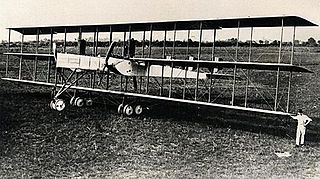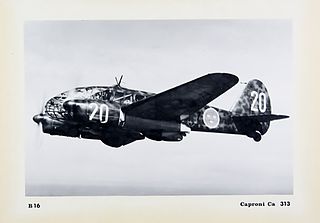Development
By late World War I, developments in aircraft technology made older bomber designs unable to penetrate targets defended by modern fighters. Caproni's response to this problem was to uprate the power significantly on the existing Ca.3 design, with some versions of the Ca.5 eventually carrying engines with nearly five times the total power that the first Ca.1 had.
Apart from greater power, various refinements were made to the design, including modifications to the main nacelle and undercarriage, and completely new wings. The first prototype flew in late 1917 and the type remained in production until 1921. Some 659 of all versions were built by Caproni, and another three were licence-built in the US (two Ca.44s by Standard, and one Ca.46 by Fisher). Planned licensed production in France was cancelled with the end of the war.
During the war, Caproni designated these aircraft according to the total power of their engines. Afterwards, the company redesignated them.
Design
The Ca.5 was a three-engine biplane of a wooden construction, covered with fabric. The crew of four was placed in an open central nacelle (front gunner, two pilots and rear gunner-mechanic). The rear gunner manned upper machine guns, standing upon the central engine in a protective "cage", just before a propeller.
Armament consisted of two to four Revelli 6.5 mm or 7.7 mm machine guns, one on a front ring mount and one, two or sometimes even three on an upper ring mount. Bombs were suspended under the hull.

The Caproni Ca.3 is an Italian heavy bomber of World War I and the postwar era. It was the most produced version of the series of aircraft that began with the 1914 Caproni Ca.1 and continued until the more powerful 1917 Caproni Ca.5 variant.

The Caproni Ca.4 was an Italian heavy bomber of the World War I era.

The Caproni Ca.1 was an Italian heavy bomber of the World War I era.

The Caproni Ca.2 was an Italian heavy bomber of the World War I era.

The Focke-Wulf Fw 191 was a prototype German bomber of World War II, as the Focke-Wulf firm's entry for the Bomber B advanced medium bomber design competition. Two versions were intended to be produced, a twin-engine version using the Junkers Jumo 222 engine and a four-engine variant which was to have used the smaller Daimler-Benz DB 605 engine. The project was eventually abandoned due to technical difficulties with the engines.

The Yakovlev Yak-2 was a short-range Soviet light bomber/reconnaissance aircraft used during World War II. It was produced in small numbers, and most of them were destroyed during the opening stages of Operation Barbarossa.

The CANT Z.1007 Alcione (Kingfisher) was an Italian three-engined medium bomber, with wooden structure. It was designed by Filippo Zappata, who also designed the CANT Z.506 and had "excellent flying characteristics and good stability". It was regarded by some as "the best Italian bomber of World War II" although its wooden structure was easily damaged by the climate, as experienced in North Africa and in Russia. It was used by the Italian Regia Aeronautica, Italian Co-Belligerent Air Force, Aeronautica Nazionale Repubblicana and Luftwaffe during World War II.

The Caproni Ca.314 was an Italian twin-engine attack/torpedo bomber aircraft, used in World War II.

The Caproni Ca.135 was an Italian medium bomber designed in Bergamo in Italy by Cesare Pallavicino. It flew for the first time in 1935, and entered service with the Peruvian Air Force in 1937, and with the Regia Aeronautica in January 1938.

The Caproni Ca.111 was a long-range reconnaissance aircraft and light bomber produced in Italy during the 1930s. It was a derivative of the Ca.101.

The Caproni Ca.101 was a three-engine Italian airliner which later saw military use as a transport and bomber. It was designed in 1927 and first flown in 1928.

The Breda Ba.201 was an Italian dive bomber designed during World War II, that never entered production.

The Caproni Ca.313 was an Italian twin-engine reconnaissance bomber of the late-1930s. It was a development of the Ca.310. Its variants were exported to several other countries.

The Caproni Ca.73 was an inverted sesquiplane aircraft designed produced by the Italian aircraft manufacturer Caproni.
The Grahame-White Ganymede was a prototype British heavy night bomber intended to serve with the Royal Air Force in the First World War. A large, three-engined, twin-boom biplane, the sole prototype Ganymede did not fly until after the war had ended, and although an attempt was made to convert the aircraft to an airliner, it was unsuccessful.

The Siemens-Schuckert L.I was a large, three-engined biplane bomber aircraft, built in Germany towards the end of World War I. It was a twin boom design, strongly influenced by the successful Caproni Ca.3. Three were built but not used operationally.

The Caproni Ca.95 was a large, three engine, long range, heavy bomber prototype built in Italy in 1929. It could carry a 1,600 kg (3,500 lb) bomb load and had three defensive gun positions. Only one was built.
The Caproni Ca.66 was an Italian night bomber designed to reequip the post-World War I Italian Air Force. Only two examples of the four-engined biplane were built.
The Caproni Ca.66 and Caproni Ca.67 were Italian night bomber aircraft designed to re-equip the post-World War I Regia Aeronautica.

The Caproni Ca.53 was an Italian prototype light bomber built in the last months of World War I.
This page is based on this
Wikipedia article Text is available under the
CC BY-SA 4.0 license; additional terms may apply.
Images, videos and audio are available under their respective licenses.

















